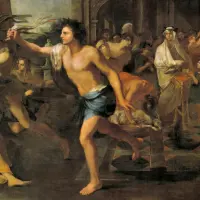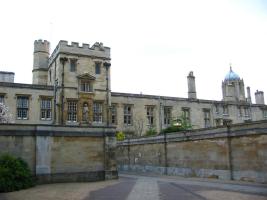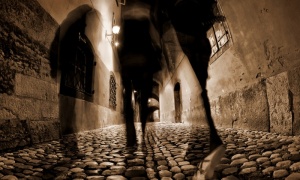John Ruskin – art critic, philanthropist and prominent social thinker – was also, by all accounts, a very odd man. Probably the most infamous aspect of his personal life was the strange annulment of his marriage to Effie Gray and the subsequent rumours that this gave rise to concerning his sexuality. He has variously been described as a prude, asexual, homosexual and even, like his contemporary and fellow Oxford man Lewis Carroll, showing an unhealthy interest in children. None of these allegations, it must be stressed, has ever been made out, which is hardly surprising given that Ruskin was an intensely private man. For this reason it is also very difficult to determine whether there is any truth in the suggestions that Ruskin received messages from a supposed former lover, Rose La Touche, even after her death and that he once encountered the Devil himself at Brantwood. With the forthcoming release of the feature film Effie, based on Ruskin’s bizarre ‘marriage’, now seems as good a time as any to examine the strange life of John Ruskin.
It must be remembered that, whatever else he was, Ruskin was the leading English art critic of the Victorian era. He also wrote on subjects ranging from geology to architecture, myth to ornithology, literature to education, and botany to political economy. Ruskin penned essays and treatises, poetry and lectures, travel guides and manuals, letters and even a fairy tale. His writing styles and literary forms were equally varied. In all of his writing, he emphasized the connections between nature, art and society. He also made detailed sketches and paintings of rocks, plants, birds, landscapes, and architectural structures and ornamentation. Educated at the University of Oxford, it was here that he first encountered Effie Gray, whom he later married, when, in answer to her challenge, he wrote his one and only fairy tale – The King of the Golden River. Oxford was not the only university with which he was associated – he gave the inaugural address at the Cambridge School of Art in 1858, an institution from which the modern-day Anglia Ruskin University has grown. Despite the fame he was to achieve during his lifetime (and the arguably even greater recognition he had after his death), Ruskin always had a troubled personal life.
Ruskin’s grandfather committed suicide and he grew estranged from his parents (they didn’t attend his wedding to Effie Gray). Ruskin suffered a string of heartbreaks – his first love, Adèle Domecq, got engaged to a French nobleman while he was at Oxford. His marriage to Effie Gray later dissolved under discord and eventually annulment. It all started when the Ruskins came into contact with John Everett Millais, a member of the Pre-Raphaelite Brotherhood. Effie and Millais fell in love, and she left Ruskin, causing a public scandal. In April 1854, Effie filed her suit of nullity, on grounds of ‘non-consummation’ owing to his ‘incurable impotency’, a charge Ruskin later disputed (in answer Ruskin wrote: “I can prove my virility at once”!). Despite this, the annulment was granted a couple of months later and Ruskin did not mention it again, even in his diary. Effie married Millais the following year. The complex reasons for the non-consummation and ultimate failure of the Ruskin marriage are a matter of continued speculation and debate.
Effie, in a letter to her parents, once claimed that Ruskin found her “person” repugnant. The cause of Ruskin’s alleged disgust (if that was what it was) has led to much speculation. Ruskin is not known to have had any sexually intimate relationships. Ruskin’s later relationship with Rose La Touche has led to claims that he was a paedophile, on the grounds that he stated that he fell in love with her when he met her at the age of nine. In fact, he did not approach Rose as a suitor until on or near her eighteenth birthday. It is possible that, in common with his contemporary, Lewis Carroll, what Ruskin valued most in pre-pubescent girls was their innocence; the fact that they were not (yet) sexual beings is what attracted him – this perhaps fits in with the common view that Ruskin was in fact devoutly asexual. Then there is the fact that for much of his life Ruskin suffered from bouts of mental illness. During one episode of mental derangement after Rose died, Ruskin wrote a letter in which he insisted that Rose’s spirit had instructed him to marry a girl who was visiting him at the time.
In 1871 Ruskin bought the 250 acre estate of Brantwood in the Lake District, a place which had been close to his heart from a very early age and where he remained until his death in 1900. Many famous artistic and literary figures visited Ruskin at Brantwood, including Dante Gabriel Rossetti (another prominent Pre-Raphaelite). It was at Brantwood that Ruskin was also, allegedly, visited by none other than the Devil himself. An entry in Ruskin’s diary reveals that he viewed the often wild and wet weather of the Lake District as potentially having a diabolical origin but that he was somehow getting the better of the Adversary. It is difficult to know what to make of such writings given that Ruskin was in an increasingly fragile mental state later in life. However, it must be said that Ruskin, always a prolific writer, continued to produce fine essays, poems and other writings on a wide range of subjects to the end of his days. Did he ‘see’ Rose (or the Devil for that matter) in one of his rare lucid periods? The speculation concerning John Ruskin will, I suspect, go on for some time yet.

















One Response to “The Strange Life of John Ruskin”